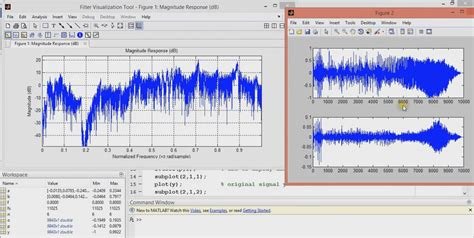Modeling and Simulation of Dynamic Systems in Matlab
Are you interested in delving into the world of dynamic systems modeling and simulation using Matlab? Whether you’re a student studying engineering or a professional looking to enhance your skills, understanding the fundamentals of modeling and simulation in Matlab can be immensely valuable. In this blog post, we will explore the key aspects of modeling and simulating dynamic systems in Matlab. We’ll start by providing an introduction to the concept of modeling and simulation and why it’s important in various industries. Then, we’ll dive into the specifics of understanding dynamic systems in Matlab and the different modeling techniques that can be used. We’ll also guide you through simulation methods in Matlab and how to effectively analyze and interpret the results. By the end of this post, you’ll have a solid foundation in using Matlab for modeling and simulating dynamic systems. So, let’s get started on this exciting journey into the world of dynamic systems in Matlab!
Introduction to modeling and simulation
Modeling and simulation are essential tools in the field of engineering, allowing engineers to study and analyze complex systems without the need for costly and time-consuming physical prototypes. By creating virtual models of real-world systems, engineers can gain valuable insights into how these systems behave under various conditions and make informed decisions about design and optimization.
Modeling involves creating a simplified representation of a real-world system, using mathematical equations and computational algorithms to describe the system’s behavior. This allows engineers to study the system’s response to different inputs, predict its future behavior, and identify areas for improvement.
Simulation, on the other hand, involves running the model to observe how the system behaves over time. By inputting different scenarios and parameters into the model, engineers can simulate the system’s performance under various conditions and analyze the effects of different design choices.
Overall, modeling and simulation are powerful tools that enable engineers to gain a deep understanding of complex systems, optimize designs, and make informed decisions without the need for costly physical prototypes.
Understanding dynamic systems in Matlab
When it comes to understanding dynamic systems in Matlab, it is important to have a good grasp of the fundamental concepts. Dynamic systems are those that change over time, and modeling them in Matlab can provide valuable insights into their behavior. One key aspect of understanding dynamic systems in Matlab is being able to define the system dynamics through mathematical equations. This involves understanding the relationships between different components of the system and how they interact with each other.
Furthermore, it is essential to have a strong understanding of how to use Matlab for simulating dynamic systems. With Matlab’s powerful simulation tools, users can create models of complex dynamic systems and analyze their behavior under various conditions. This allows for a deeper understanding of the system’s dynamics and how different input variables can affect its behavior.
Another important aspect of understanding dynamic systems in Matlab is being able to interpret simulation results. This involves analyzing the data generated from the simulations and drawing meaningful conclusions about the system’s behavior. By visualizing the results and comparing them with theoretical expectations, users can gain valuable insights into the underlying dynamics of the system.
In conclusion, having a comprehensive understanding of dynamic systems in Matlab involves being able to define the system dynamics, simulate the system’s behavior, and interpret the simulation results. By mastering these concepts, users can gain valuable insights into the behavior of dynamic systems and make informed decisions about their future development.
Modeling techniques for dynamic systems
When it comes to modeling techniques for dynamic systems, there are several approaches that can be used to effectively represent and understand the behavior of these complex systems. One common technique is to use mathematical equations to describe the relationships between the various components of the system. This allows for the creation of models that can be used to predict the behavior of the system under different conditions.
Another approach to modeling dynamic systems is through the use of simulation software such as Matlab. This allows for the creation of virtual models that can be used to explore the behavior of the system in a controlled environment. By adjusting the parameters and inputs, it is possible to gain valuable insights into how the system will behave under different scenarios.
One key aspect of modeling dynamic systems is the ability to validate the models that are created. This involves comparing the model’s predictions with real-world data to ensure that it accurately represents the behavior of the system. This can be a challenging task, as dynamic systems are often complex and non-linear, but it is essential for ensuring the reliability of the models.
Overall, the use of modeling techniques for dynamic systems is a powerful tool for gaining a deeper understanding of these complex systems. Whether through the use of mathematical equations or simulation software, the ability to create and validate models can provide valuable insights that can be used to make informed decisions and improve the performance of these systems.
Simulation methods in Matlab
Simulation methods in Matlab are essential for understanding and analyzing complex dynamic systems. With the use of advanced computational tools and algorithms, engineers and scientists can simulate the behavior of systems in a virtual environment. This allows for testing and analyzing the system’s response under various conditions without the need for physical prototypes. Matlab provides a wide range of simulation methods, including continuous and discrete-time simulations, event-driven simulations, and stochastic simulations.
One of the key simulation methods in Matlab is the use of Simulink, which is a powerful graphical environment for modeling, simulating, and analyzing dynamic systems. Simulink allows for the creation of block diagrams and models to represent the behavior of the system, making it an intuitive and efficient tool for simulation. With Simulink, users can implement various simulation methods such as time-domain simulation, frequency-domain simulation, and state-space simulation.
Another important simulation method in Matlab is the use of Monte Carlo simulation, which is widely used for analyzing the behavior of systems under uncertainty. This method involves running multiple simulations with random input variables to estimate the probability distribution of the system’s response. Matlab provides built-in functions and tools for implementing Monte Carlo simulations, making it a versatile and reliable tool for uncertainty analysis.
Overall, simulation methods in Matlab offer a comprehensive and flexible approach to understanding and analyzing dynamic systems. The use of advanced computational tools, such as Simulink and Monte Carlo simulation, enables engineers and scientists to gain valuable insights into the behavior of complex systems and make informed decisions based on the simulation results.
Analyzing and interpreting simulation results
When it comes to simulation results, it is important to have a clear understanding of how to analyze and interpret the data. One of the key steps in this process is to identify the variables that are of interest and to establish the appropriate measures for assessing their behavior.
Once the simulation is run, the next step is to evaluate the results. This involves looking at how the different components of the system interact with each other, as well as examining any patterns or trends that emerge.
It is also important to consider the uncertainty and sensitivity of the results. This can involve conducting sensitivity analyses to test the robustness of the model and its outputs, as well as looking at the potential impact of different input parameters.
Finally, the interpretation of the simulation results is crucial for making informed decisions and drawing meaningful conclusions. This can involve comparing the results with real-world data, as well as considering the implications of the findings for the system being studied.


